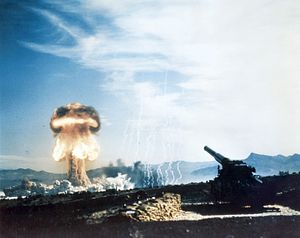On Monday, a top Pakistani official confirmed what had long been suspected by the arms control community: Pakistan will use low-yield nuclear weapons in responding to hypothetical Indian incursions into its territory. According to Pakistani Foreign Secretary Aizaz Chaudhary, Pakistan is formalizing it’s plans to use these low-yield nuclear bombs to forestall the advance of Indian troops under New Delhi’s “Cold Start” doctrine. Chaudhary’s statement marks the first time Pakistani officials have acknowledged their intent to use low-yield, or so-called “tactical,” nuclear weapons in a potential future conflict with India. India does not currently operate or plan to develop tactical nuclear weapons.
Pakistan’s research and development efforts into tactical nuclear weapons have been an open secret for some time. Khalid Kidwai, the longest serving head of Pakistan’s Strategic Plans Division, the branch of the armed forces tasked with securing and maintaining the country’s nuclear arsenal, had called earlier this year for short-range nuclear weapons. Though observers often distinguish between long-range, high-yield “strategic” nuclear weapons and short-range, low-yield “tactical” nuclear weapons, no formal distinction exists between the two types of weapons. In the eyes of the international community, even the use of a low-yield nuclear weapon in wartime would mark a significant escalation and increase the risk of all-out nuclear war between India and Pakistan. Pakistani experts, including Kidwai, have denied that Pakistan’s plans to operationalize short-range nuclear weapons would realistically increase the risk of nuclear war in South Asia.
Independent experts generally regard Pakistan’s deployment of short-range, low-yield nuclear weapons as problematic and risky. Jeffrey D. McCausland, writing for the Stimson Center, notes that “the belief held by some Pakistani military leaders that the development, production, and induction of tactical nuclear weapons would cancel Indian conventional advantages while facilitate ‘sub-conventional’ warfare is both dangerous and problematic.” Notably, tactical nuclear weapons lower the threshold for nuclear weapon use by Pakistan considerably. Chaudhary’s offered rational for Pakistan’s “tactical” weapons refers to India’s so-called “Cold Start” doctrine, which is as of yet not an official part of Indian military doctrine. Under Cold Start, Indian conventional forces would conduct coordinated offensive operations into Pakistan and conduct limited warfare; Cold Start emphasizes speedy and lithe offensive operations. From the Pakistani perspective, battlefield use of tactical nuclear weapons would stop Indian forces dead in their tracks. Unsaid in Chaudhary’s remarks on Pakistan’s tactical weapons is the notion that Pakistan would essentially resort to nuclear weapon use on its own territory to slow down an Indian advance.
As a final thought, I find it notable that Chaudhary chose a press conference briefing the media on Pakistani Prime Minister Nawaz Sharif’s upcoming state visit to the United States to acknowledge Pakistan’s plans to deploy low-yield nuclear weapons. In recent weeks, following two separate reports by the Washington Post‘s David Ignatius and the New York Times‘ David Sanger, rumors that the United States is planning on offering Islamabad a “nuclear deal” have abounded. A U.S.-Pakistan deal would grant Pakistan access to civilian nuclear technology and access to global nuclear commerce in exchange for a freeze in the growth of Islamabad’s nuclear arsenal. There are a range of reasons why this would be a questionable move for the United States (Dhruva Jaishankar catalogues many of them over at Foreign Policy).
Chaudhary clarified that no nuclear deal would come out of Sharif’s visit to Washington this week, but the Pakistani prime minister may well end up discussing the issue with Obama. Washington is understandably highly sensitive to the possibility of nuclear weapon use in South Asia and has historically worked with Pakistan to ensure that its nuclear arsenal remains out of the hands of terrorists. While U.S. intelligence has been aware of Pakistan’s development of tactical nuclear weapons for some time, having the country’s foreign secretary mention it before a state visit is a great way for Pakistan to emphasize the development. In essence, this is as much about signaling to the United States as it is to India over its potential war-fighting plans.
Thus, for Sharif, Chaudhary’s remark on tactical nuclear weapons adds additional leverage to the Pakistani position should negotiations for a nuclear deal actually begin in earnest. A nuclear deal for Pakistan could end up being a non-starter, but clarifying the conditions for tactical nuclear weapon will only increase Washington’s anxieties about possible future conflicts in South Asia.

































